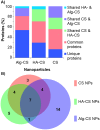Hyaluronic Acid Coated Chitosan Nanoparticles Reduced the Immunogenicity of the Formed Protein Corona
- PMID: 28874846
- PMCID: PMC5585335
- DOI: 10.1038/s41598-017-10836-7
Hyaluronic Acid Coated Chitosan Nanoparticles Reduced the Immunogenicity of the Formed Protein Corona
Abstract
Studying the interactions of nanoparticles (NPs) with serum proteins is necessary for the rational development of nanocarriers. Optimum surface chemistry is a key consideration to modulate the formation of the serum protein corona (PC) and the resultant immune response. We investigated the constituent of the PC formed by hyaluronic acid-coated chitosan NPs (HA-CS NPs). Non-decorated chitosan NPs (CS NPs) and alginate-coated chitosan NPs (Alg-CS NPs) were utilized as controls. Results show that HA surface modifications significantly reduced protein adsorption relative to controls. Gene Ontology analysis demonstrates that HA-CS NPs were the least immunogenic nanocarriers. Indeed, less inflammatory proteins were adsorbed onto HA-CS NPs as opposed to CS and Alg-CS NPs. Interestingly, HA-CS NPs differentially adsorbed two unique anti-inflammatory proteins (ITIH4 and AGP), which were absent from the PC of both controls. On the other hand, CS and Alg-CS NPs selectively adsorbed a proinflammatory protein (Clusterin) that was not found on the surfaces of HA-CS NPs. While further studies are needed to investigate abilities of the PCs of only ITIH4 and AGP to modulate the interaction of NPs with the host immune system, our results suggest that this proof-of-concept could potentially be utilized to reduce the immunogenicity of a wide range of nanomaterials.
Conflict of interest statement
The authors declare that they have no competing interests.
Figures






Similar articles
-
Development of chitosan nanoparticles coated with hyaluronic acid for topical ocular delivery of dexamethasone.Int J Biol Macromol. 2016 Aug;89:127-36. doi: 10.1016/j.ijbiomac.2016.04.070. Epub 2016 Apr 25. Int J Biol Macromol. 2016. PMID: 27126165
-
Alginate coated chitosan core shell nanoparticles for oral delivery of enoxaparin: in vitro and in vivo assessment.Int J Pharm. 2013 Nov 1;456(1):31-40. doi: 10.1016/j.ijpharm.2013.08.037. Epub 2013 Aug 29. Int J Pharm. 2013. PMID: 23994363
-
Ocular tolerance to a topical formulation of hyaluronic acid and chitosan-based nanoparticles.Cornea. 2010 May;29(5):550-8. doi: 10.1097/ICO.0b013e3181bd9eee. Cornea. 2010. PMID: 20335805
-
Understanding the Factors Influencing Chitosan-Based Nanoparticles-Protein Corona Interaction and Drug Delivery Applications.Molecules. 2020 Oct 16;25(20):4758. doi: 10.3390/molecules25204758. Molecules. 2020. PMID: 33081296 Free PMC article. Review.
-
The interaction between nanoparticles-protein corona complex and cells and its toxic effect on cells.Chemosphere. 2020 Apr;245:125624. doi: 10.1016/j.chemosphere.2019.125624. Epub 2019 Dec 12. Chemosphere. 2020. PMID: 31864050 Review.
Cited by
-
Controlling evolution of protein corona: a prosperous approach to improve chitosan-based nanoparticle biodistribution and half-life.Sci Rep. 2020 Jun 15;10(1):9664. doi: 10.1038/s41598-020-66572-y. Sci Rep. 2020. PMID: 32541900 Free PMC article.
-
Heterocellular spheroids of the neurovascular blood-brain barrier as a platform for personalized nanoneuromedicine.iScience. 2021 Feb 12;24(3):102183. doi: 10.1016/j.isci.2021.102183. eCollection 2021 Mar 19. iScience. 2021. PMID: 33718835 Free PMC article.
-
Quantitative comparison of the protein corona of nanoparticles with different matrices.Int J Pharm X. 2022 Oct 21;4:100136. doi: 10.1016/j.ijpx.2022.100136. eCollection 2022 Dec. Int J Pharm X. 2022. PMID: 36304137 Free PMC article.
-
Chitosan-Based Nanomaterials for Drug Delivery.Molecules. 2018 Oct 16;23(10):2661. doi: 10.3390/molecules23102661. Molecules. 2018. PMID: 30332830 Free PMC article. Review.
-
Surface antibody changes protein corona both in human and mouse serum but not final opsonization and elimination of targeted polymeric nanoparticles.J Nanobiotechnology. 2023 Oct 14;21(1):376. doi: 10.1186/s12951-023-02134-4. J Nanobiotechnology. 2023. PMID: 37838659 Free PMC article.
References
-
- Lynch I, Dawson KA. Protein-nanoparticle interactions. Nano Today. 2008;3:40–47. doi: 10.1016/S1748-0132(08)70014-8. - DOI
Publication types
MeSH terms
Substances
LinkOut - more resources
Full Text Sources
Other Literature Sources
Miscellaneous

